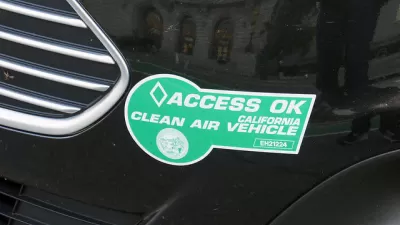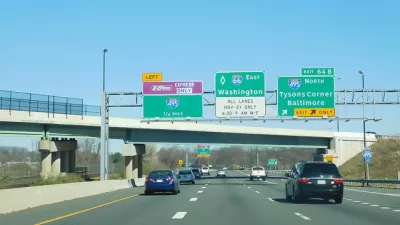Since transportation agencies decided to make carpool lanes available for non-carpoolers (toll-paying solo drivers or electric vehicles), they've become congested in some metro areas, which can violate federal conditions on their use.

Express lanes, also called high-occupancy toll or HOT lanes, or simply toll lanes by opponents who overlook the fact that carpoolers continue to use the lanes toll-free, enable single-occupant vehicles to use the high-occupancy vehicle (HOV) or carpool lane for a toll.
Many express lanes now use dynamic tolling which means that as the level of traffic in the lane increases, so does the charge to discourage additional motorists from using it. Federal guidelines for HOV lanes require the speed to be at least 45 mph for 90 percent of the time.
"But last year, during evening rush hour, Florida drivers going northbound on Interstate 95 only traveled faster than 45 mph ... 65 percent of the time," reports Rebecca Beitsch for Stateline.
So much for calling them 'Lexus Lanes,' a moniker devised by an early opponent, California state Sen. Tom Hayden, who charged that only wealthy motorists would opt to use them since adjacent lanes were 'free' though likely operating at slower speeds during peak hours.
But single occupant vehicles are not always to blame for congestion in the carpool lane.
Average speeds are now below 45 mph on nearly half of the San Francisco Bay Area’s carpool lanes. As a result, drivers of electric vehicles who have a state-issued tag to drive on express lanes are now barred from some Bay Area lanes during peak congestion times, up to an hour each morning. Transportation officials say similar restrictions may be put in place on other Bay Area highways.
Meanwhile, California legislators last week declined to raise the current 85,000 cap on the number of [plug-in] hybrid vehicles allowed to ride on California’s HOV lanes for free. Over the past several years, lawmakers had raised the cap by 15,000 on three separate occasions. [See Green Clean Air Vehicle decals and AB-1964: High-occupancy vehicle lanes: vehicle exceptions.]
The Los Angeles County Metropolitan Transportation Authority (Metro) takes a different approach to congestion on the on the I-110 and I-10 express lanes in Los Angeles County. In response to the FAQ: "What happens if the lanes become too full?":
If the lanes become too full and the tolls have reached the maximum amount, the message displayed on the overhead sign will change to "HOV ONLY". This message informs potential toll paying drivers that they will not be allowed to enter the ExpressLanes until the speeds climb back up to at least 45 mph. If you are a toll-paying driver already using the ExpressLanes when the sign message changes to "HOV ONLY" you will be able to complete your trip.
"Kathy McCune, deputy director of Los Angeles County’s Metropolitan Transportation Authority, said the region’s express lanes are so congested it may become necessary to require ...electric vehicles to pay at least a partial toll," adds Beitsch.
Why not keep raising the toll?
There are limits as to how high the agency can raise tolls.
"In Georgia, the express lanes have proven so popular...that the state has already reached the $13.95 limit (the toll for driving the full 16 miles) it vowed not to exceed when the program started.
Last year tolls on the 'oversubscribed' Los Angeles Harbor (110) Freeway Express Lanes ranged from 25 cents to $1.40 a mile, for a maximum one-way price of $15.40 along the 11-mile route.
David Levinson, a researcher at the University of Minnesota, said that when express tolls rise, many drivers take it as a sign that regular lanes are congested, rather than realizing that it means that the express lanes are especially crowded.
Public Transit?
Chris Tomlinson, who heads Georgia’s State Road and Tollway Authority, now has his eyes on getting more people to use the buses that run in the express lanes.
Last year, Georgia experimented with allowing people to earn toll credits for riding the bus — up to $60 in six months — to save them money on the days they choose to drive. The state is considering expanding the program to more drivers if it can find the money for it
The irony of the congested carpool lane problem is that "the percentage of commuters who carpool has been falling since the U.S. Census Bureau began tracking numbers in 1980," notes Beitsch.
Back then, 20 percent of commuters carpooled to work. The carpooling percentage declined to 13 percent in 1990 and 12 percent in 2000. Today it is only 9 percent.
Also on Planetizen:
- Los Angeles HOT Lanes Have an Oversubscription Problem, March 27, 2015
- Are There More Lexus Drivers in Florida?, January 2, 2014
Hat tip to The AASHTO Daily Transportation Update
FULL STORY: Express Lanes Have a Popularity Problem

Alabama: Trump Terminates Settlements for Black Communities Harmed By Raw Sewage
Trump deemed the landmark civil rights agreement “illegal DEI and environmental justice policy.”

Study: Maui’s Plan to Convert Vacation Rentals to Long-Term Housing Could Cause Nearly $1 Billion Economic Loss
The plan would reduce visitor accommodation by 25% resulting in 1,900 jobs lost.

Planetizen Federal Action Tracker
A weekly monitor of how Trump’s orders and actions are impacting planners and planning in America.

Federal Homelessness Agency Places Entire Staff on Leave
The U.S. Interagency Council on Homelessness is the only federal agency dedicated to preventing and ending homelessness.

Restoring Northern India’s Himalayan ‘Water Temples’
Thousands of centuries-old buildings protect the region’s natural springs and serve as community wells and gathering places.

Milwaukee to Double Bike Share Stations
Bublr Bikes, one of the nation’s most successful, will add 500 new e-bikes to its system.
Urban Design for Planners 1: Software Tools
This six-course series explores essential urban design concepts using open source software and equips planners with the tools they need to participate fully in the urban design process.
Planning for Universal Design
Learn the tools for implementing Universal Design in planning regulations.
Caltrans
Smith Gee Studio
Institute for Housing and Urban Development Studies (IHS)
City of Grandview
Harvard GSD Executive Education
Toledo-Lucas County Plan Commissions
Salt Lake City
NYU Wagner Graduate School of Public Service




























